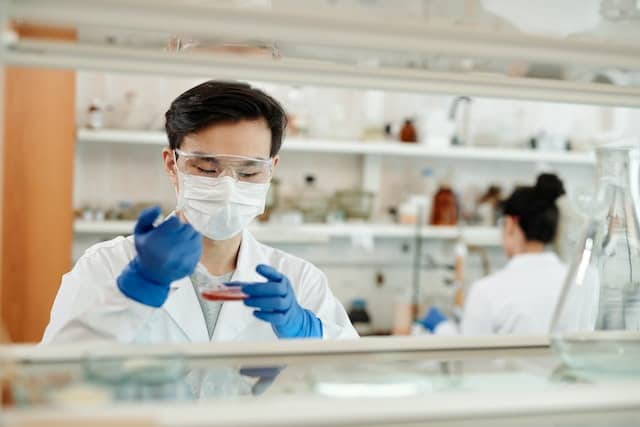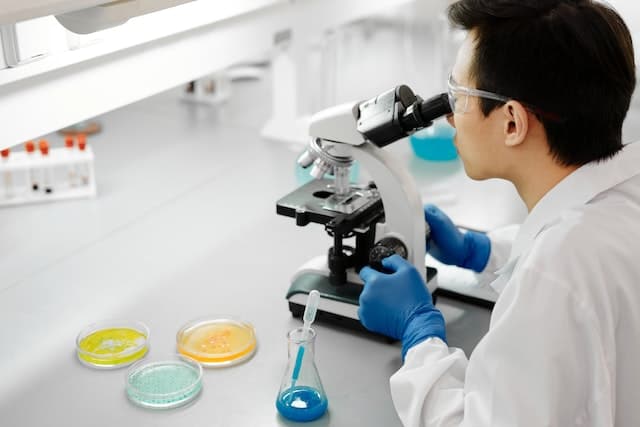The use of microbes in biotechnology has become a widely studied field due to the many potential benefits that microbes can bring to the industry.
In the past, we often see microbes as agents of disease, but today, industrial biotechnology uses them to create solutions to numerous challenges.
The development of new technologies in microbiology that rely on microbes has unlocked a range of possibilities, from creating more efficient fertilizers and pesticides to producing more effective vaccines and medications.
Through harnessing the power of microbes, biotechnologists are able to manipulate and modify them to produce desired results.
This article will cover the beneficial uses of microbes in biotechnology and explore how their utilization can lead to advancements in numerous industries.

What are the Beneficial Uses of Microbes in Biotechnology?
Microbes have a wide range of beneficial uses in biotechnology. Microbes are also considered excellent materials for biotechnology due to their diverse metabolic potentials and established manipulation techniques.
Moreover, microbial genomics and microbial biotechnology research are critical for advances in food safety, food security, biotechnology, value-added products, and human health.
Therefore, here are some important benefits of microbes in biotechnology that you have to know.
1. Produce Antibiotics
One of the most beneficial uses of microbes in biotechnology is the use of bacteria to produce antibiotics.
Bacteria, such as Streptomyces, are naturally capable of producing antibiotics that can be used to treat various illnesses.
Through genetic engineering, scientists have modified these bacteria to produce new types of antibiotics which are more effective than existing ones.
These new antibiotics can be used to treat infections and diseases caused by pathogens, such as bacteria, viruses, and fungi.
Additionally, bacteria are useful to produce enzymes through their metabolic pathways that have been used to create drugs such as insulin and other life-saving therapies.
2. Using Yeasts in Brewing and Baking
One of the oldest and most widely used applications of biotechnology is the use of yeast in brewing and baking.
Yeast is a single-celled fungus that has the ability to ferment carbohydrates to produce ethanol and carbon dioxide in anaerobic conditions. The consumption of glucose by yeast yields is useful for making bread, beer, and wine.
Yeast fermentation is one of the most efficient and cost-effective methods for producing alcohol, as well as many other products.
In addition, the food industry also uses yeast in the production of many other food products, such as cheese.
3. Food Production
One of the most exciting and innovative uses of microbes in biotechnology is the production of food. Through industrial processes, the food industry uses bacteria to produce products such as cheese and yogurt.
Through fermentation and metabolic pathway, bacteria break down sugars and convert them into acids, alcohols, and other compounds.
Therefore, this process can be used to increase the nutritional value of food. For example, probiotics, which are beneficial bacteria, can be added to food to increase its health benefits.
The use of bacteria for food production is an efficient and cost-effective way to produce high-quality and nutritious food.
4. Biofuel Production
One of the most beneficial applications of microbes in biotechnology is the use of bacteria for biofuel production.
Microbial biotechnology can use bacterial cells to produce biofuels such as biodiesel and ethanol. These biofuels are renewable and have been proven to be much more efficient than traditional fossil fuels.
Scientists can also genetically engineer bacteria to produce fuels that are more efficient and cost-effective. This process is still in the early stages of development but holds great potential in the future.
5. Genetic Engineering
One of the most effective and beneficial uses of microbes in biotechnology is using bacteria for genetic engineering.
This technology involves introducing new genetic material into existing organisms, allowing them to express desired traits and characteristics.
Through this process, scientists can create plants and animals that are resistant to disease or can produce higher yields of food and other products.
Bacterial genetic engineering is also used to create proteins for medical treatments and to develop vaccines for diseases.
This technology has revolutionized biotechnology and has many potential applications in the future.
6. Bioremediation
One of the most beneficial uses of microbes in biotechnology is bioremediation, which is the use of bacteria to clean up environmental contaminants.
This process involves introducing a certain species of bacteria into contaminated sites to break down toxic substances.
Bacteria can also be beneficial to produce enzymes that break down pollutants and remove them from the environment.
One example of this is the use of genetically modified bacteria to clean up oil spills.
This process is much less expensive and more efficient than traditional methods of cleanup, and it has proven to be an effective way of reducing environmental damage.
7. Produce Enzymes
One of the many beneficial uses of microbes in biotechnology is the production of enzymes.
Microbes are used to produce many enzymes, such as amylases and proteases, which are essential for a variety of applications.
We can use enzymes for the production of biofuels, food and beverage processing, and also for the pharmaceutical industry, among many others.
Microbes are particularly useful for the production of enzymes because their microbial activity is quick and researchers can tailor them to specific needs.
As a result, many industries rely on the production of enzymes by microbes.
8. Bioindicator
In microbial ecology, microbes are useful as bioindicators to detect the presence of environmental pollutants, such as heavy metals, and other hydrocarbons.
By selectively culturing different types of potential bacteria, it is possible to detect the presence of specific contaminants.
In addition, microorganisms are also indicators of soil health and quality, and we can use microbial assemblages as proxies for environmental health status.
The use of microbes to monitor environmental pollution has become increasingly important as the world is faced with an ever-growing number of hazardous contaminants.

Final Thoughts
Microbes have revolutionized biotechnology and have a wide range of beneficial uses.
They can be used to produce food and fuel, clean up environmental pollutants, and even fight diseases.
With the right knowledge and application, microbes can be incredibly helpful in improving our lives.
The potential of microbes in biotechnology is exciting and, with further research, they may even be used to solve some of the world's most pressing problems.
Cudy helps connect tutors, students, and parents to conduct and schedule online lessons anytime and anywhere. Join Cudy and subscribe to our blog for many study tips and more!
FAQs
How are microbes beneficial to biotechnology?
Microbes are beneficial to biotechnology in many ways. They have diverse metabolic potentials in industrial processes to produce organic acids, providing traditional fermented foods, and polymeric materials.
What microbes are significant for biotechnology?
Microbes are significant for biotechnology due to their diverse metabolic potentials and established manipulation techniques. Examples of microbes used in biotechnology include yeast, lactic acid bacteria, fungi such as Penicillium roqueforti, and archaea microorganisms.
What is the most important in biotechnology?
The most important area of biotechnology is it has implications in health and medicine through genetic engineering.
What is biotechnology in microbiology?
Biotechnology in microbiology is the use of biological systems, living organisms, or parts of them to develop or create different products.
What are the three beneficial functions of microbes?
Microbes have three beneficial functions, such as playing defense against pathogens, providing nutrients to plants, and decomposing dead organisms and waste to recycle nutrients.